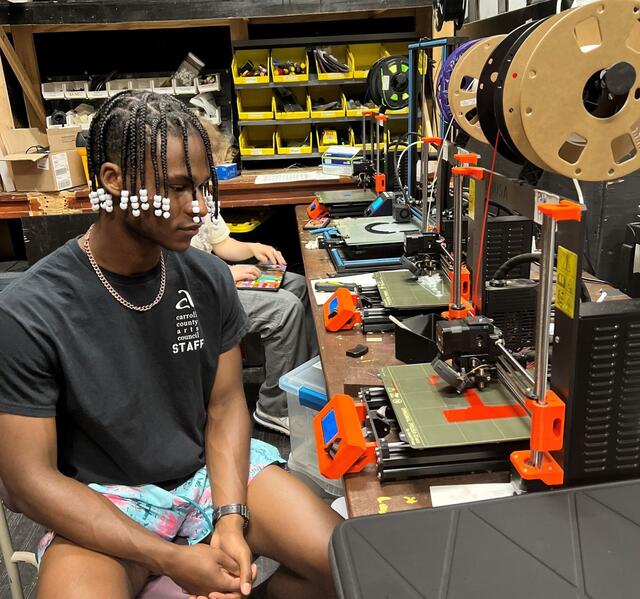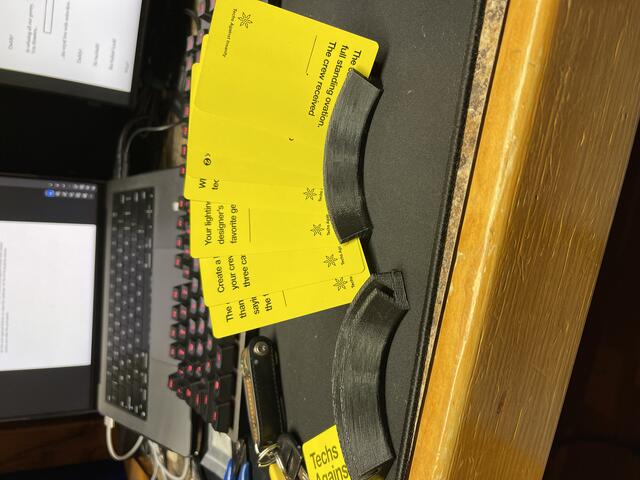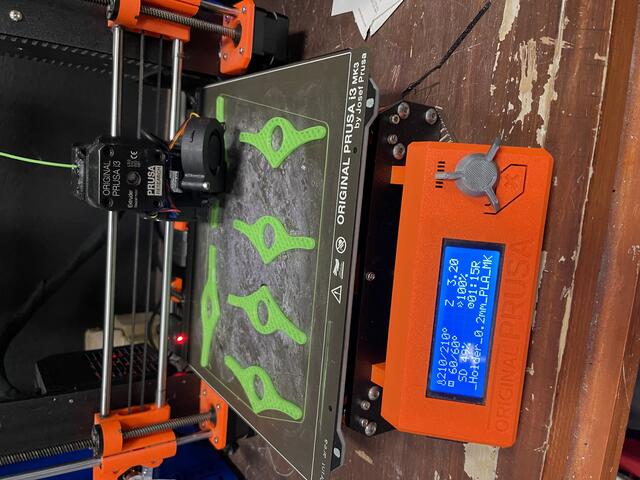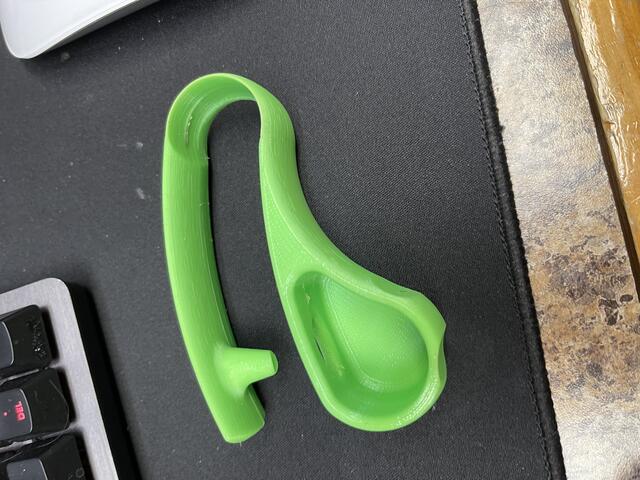From Bridgerton to X-Men: students 3D print theatre props and accessibility tools
What do a prop gun and a fidget spinner have in common? They can both be 3D printed! In Theatrical 3D Printing & Props, Assistant Professor Shana Joslyn teaches students the ins and outs of 3D printing, and they use it to create props inspired by their favorite shows and movies. To demonstrate how these technological skills apply to many fields, the class connects with McDaniel's Student Accessibility and Support Services office to create accessibility items for the campus community.

Charlie Hoyle, junior Cinema-Theatre Arts major designed a replica of an X-Men prop for his final project in Theatrical 3D Printing & Props.
In Theatrical 3D Printing & Props, McDaniel students are learning the role that technology plays in finding solutions — and that it’s sometimes the star of the show.
Taught by Shana Jung Ah Joslyn, assistant professor of theatre design and technology, students in the Theatre Arts course aren’t reciting monologues or acting out balcony scenes — they’re 3D printing.
“People don’t realize that we can get into this type of technical work in theater,” Joslyn says. “They don’t think about how much tech we use in the fine arts.”
In 2021, Joslyn received the Ira G. Zepp Teaching Enhancement Grant for her proposal to set up a mobile 3D printing farm on campus to introduce the technical side of theatre arts to the Hill.
“I’ve always been interested in 3D printing,” Joslyn says. “In the theatre, we make lots of props, so I was very excited when we got the Fused Deposition Modeling printers and I was able to design a class around them.”
The cross-disciplinary course includes many non-Theatre Arts majors, since learning how to 3D print can apply to various professional fields, including medicine, dentistry, engineering, design, fashion, physical therapy, and construction.
“I just love this class, and I hope one day I can buy my own 3D printer,” says Dasia Dorsey, senior Psychology major from Dundalk, Maryland, who was excited to combine creativity and engineering to customize anything she can dream up.
From modeling to printing, students learn valuable skills

Taeyanna Jones works on the model of her Bridgerton-inspired final project.
First-year student Chris Hand of Newfoundland, New Jersey, was 3D printing as a hobby before the class but has now deepened his understanding of the process.
“I got to try a new filament and learned more of the terminology and anatomy of the printer,” he says.
3D printing takes a digital model of an item as a blueprint, then layers strands of plastic into the model shape to create a product quickly and at low cost.
“I always thought that the mechanics of a 3D printer were super cool, and I really wanted to learn how to use the software,” says Kim Parson, who is a senior Theatre Arts major from Westminster, Maryland.
Using programs called Tinkercad and Thingiverse, the students learn the basics of printing theatre props, from printer calibration to model design, then create their own props for the final assignment.
For students in the class, the stuff of fantasy and science fiction become easy to fabricate, only limited by the creator’s imagination and the size of the printer.
Like many of her classmates, Taeyanna Jones, a senior Psychology major from Baltimore, was inspired by pop culture when designing her final item: a Bridgerton croquet wicket, drawn by hand in the modeling software.
“I’ve loved this class a lot,” says Tyra Pritchett, a senior Psychology major with a minor in Theatre Arts from Hanover, Maryland. “I’ve learned you can do whatever you want with a 3D printer. That’s my favorite thing about this class, that you’re just able to let your creativity flow.”
3D printing provides a practical solution
Props printed for theatre productions are used right on campus. Joslyn recently 3D printed safe prop pistols for the 2023 performance of “Heathers The Musical,” and has even printed set embellishments for windows and doors.

Noah Carpenter watches a 3D printer produce a grocery bag holder, an accessibility tool, as part of his final project.
Charlie Hoyle, a junior Cinema-Theatre Arts major from Newton, North Carolina, created props by hand in high school, and finds 3D printing to be far more practical.
“I used a lot of foam and spray paint back then,” he says. “So, this is a lot of fun because I don’t have to model it in real life, which, if that doesn’t go well you have to start over. If it doesn’t model well for 3D printing, I can just delete it and retry and not waste money on materials.”
Many of the students’ final projects take upwards of 10 hours to print, and some require making separate components. Hoyle’s final print, Cyclops’ visor from the X-Men franchise, took 15 hours.
“This class has taught me to be thorough,” says Noah Carpenter, a senior Theatre Arts major from Silver Spring, Maryland. “Even the slightest mistake can ruin a print. It’s okay to aim for perfection to get the best results.”
Creating accessibility tools for the McDaniel community
Beyond the theatre, Joslyn wants her students to know that 3D printing is a valuable tool that can provide solutions in many areas of life.
“There’s a lot you can do with 3D printing,” Joslyn says. “Some people think it’s just for toys and trinkets. I want people to know that we can use it for functional, useful devices that help people daily.”
In addition to props, students were tasked with making something useful to everyday life, like over-the-door hooks, boxes, grocery bag carriers, gas cap openers, inhaler pumps, and even replacement parts for a fridge door.
Even before she began teaching Theatrical 3D Printing & Props, Joslyn used 3D printers to produce personal protective equipment like face shields during the COVID-19 pandemic. “Since then, I’ve helped anywhere I can with 3D printing,” she says.
Particularly inspired by 3D-printed prosthetics, Joslyn wanted students to explore the many possibilities of the technology. “The first time I ran this class, I looked into different types of assistive technology, since we can make items to help people,” she says.
Joslyn includes a unit in the course on accessibility and has students research assistive technology and types of tools they can print. Joslyn also reached out to McDaniel’s Student Accessibility and Support Services (SASS) Office to learn what items would be most useful to share with students on campus.
"The 3D printed items that this class created are widely used by the students in the SASS Office," says Melanie Conley, director of SASS. "We all appreciate the inclusive efforts of the class to provide items to assist our students. A favorite this year is an adorable dinosaur fidget!"
For the cost of a few pennies, the class printed batches of fidget spinners, bottle openers, book holders, and peelers. Each item was made by students, for students.

3D printed cardholder. |

One-handed book holders. |

Blister pack opener. |
“The accessibility portion of the class is important because everyone should learn about tools that can make lives easier and do what they can to provide them, because everyone deserves to get around,” Joslyn says.
Asher Palmer, a first-year Social Work major from Parkville, Maryland, has become the “resident fidget spinner maker” among her friends. “I’m neurodivergent and I have a bunch of neurodivergent friends, so I’ve printed fidget spinners for all of them.”
By incorporating STEM, programming, machinery, and design within the scope of the theatre — and beyond — students are exploring the possibilities that technology opens up in every field.